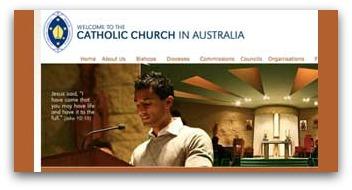By Andrew Hamilton
Eureka Street
October 12, 2011
www.eurekastreet.com.au/article.aspx?aeid=28525
 |
Most Australian Catholic Bishops are in Rome this week for their five yearly joint visit to the Vatican. Most popular reflection on the visit has focused on issues internal to the Catholic Church, such as the dismissal of Bishop Bill Morris, the handling of sexual abuse and the introduction of the new translation of the Mass.
But the conversations involved in the visit will certainly also cover the broader situation of the Catholic Church in Australia and pastoral strategies appropriate to it. The papal emphasis on New Evangelisation, with its emphasis on winning back non-practising Catholics and on commending the Gospel in a secular society may focus this discussion.
It is helpful to set reflection on Catholic pastoral strategy in a larger context. The situation in Australia, as indeed more generally in the West, is not specific to the Australian Catholic Church. It is shared with other mainstream churches. It also characterises other voluntary groups in society, such as political parties and service groups.
Most churches are ageing and diminishing in numbers. They struggle to communicate an understanding of church beliefs to their children or to win them to church allegiance. As a result those with a strong understanding of faith are elderly. Ministers within churches are also fewer and ageing.
The diminishing number of clergy and of well-grounded church members puts pressure on outreach to needy groups and on the churches'voice in society. The call on resources means that there are fewer ministers available for full time grass roots involvement in hospitals, prisons, schools and so on.
In church organisations involved in these fields, too, it is harder to find young administrators who are both professionally qualified and have hands on experience through the churches.
This double hollowing out tends to limit churches' engagement with governments on public policy. Church leaders are more likely to see themselves as uninformed. They also face greater demands in caring for the good order and maintenance of their churches. The public voice of the churches becomes muted.
The goals that the pastoral strategy of any church needs to set itself are to nurture the faith of those who are committed, to pass on faith to the next generation, to attract to the church those who are on its margins and outside, and to commend Christian values in public life.
In reaching these goals, the Catholic Church does face specific challenges. The allegiance of many committed and well-instructed Catholics has been tried by the response to sexual abuse, to the marginalisation of women and to what is seen as high-handed Vatican exercise of authority.
The Catholic Church also gives a high place to priests in leadership of local communities. But at a time when there are few candidates for priesthood, the limitation of future priests to unmarried men makes it difficult to supply that leadership.
The Australian Catholic Church also has some distinctive resources. It includes a high proportion of migrants whose teenage children often attend church more regularly than those of the Catholic population as a whole. It also has a strong institutional presence in health, social outreach and education with much stored wisdom.
In similar situations dramatic solutions are always seductive. Savanarola's Florence and Calvin's Geneva represent the attraction of a return to fervent antiquity. So did Mao's Cultural Revolution, with its attempt to rejuvenate the spirit of the Long March by demonising and harrying older Chinese for their laxity, and co-opting the enthusiastic young so they could lead the nation back to the simplicities of the early revolution. Their children, of course, inherited the spoils of their later turn to acquisitiveness.
More effective strategies will build on the strengths of the Catholic Church. They will include valuing the wisdom and familiarity with the full Catholic tradition of older Catholics, and encouraging them to share their wisdom.
They will also look to nurture leadership within the laity, from whom must come the energy for church renewal and responsibility for commending the Gospel to society. The Catholic educational, spiritual, health and outreach organisations are the natural resource for developing lay leadership. Priests, of course, have a central place in animating lay leadership.
Any strategy will also need to focus on young Catholics, offering them opportunities to grow in their understanding of faith and in spiritual depth. It will also be vital for them to have opportunities to work with marginalised groups, so that future Catholic engagement with society is based in companionship with the poor.
Whatever pastoral strategy is followed, however, it is unlikely to produce quick or dramatic results. The cultural and economic factors that have contributed to their diminishment are not conducive to rapid growth. But they do open a new space for open and committed churches.
Any original material on these pages is copyright © BishopAccountability.org 2004. Reproduce freely with attribution.